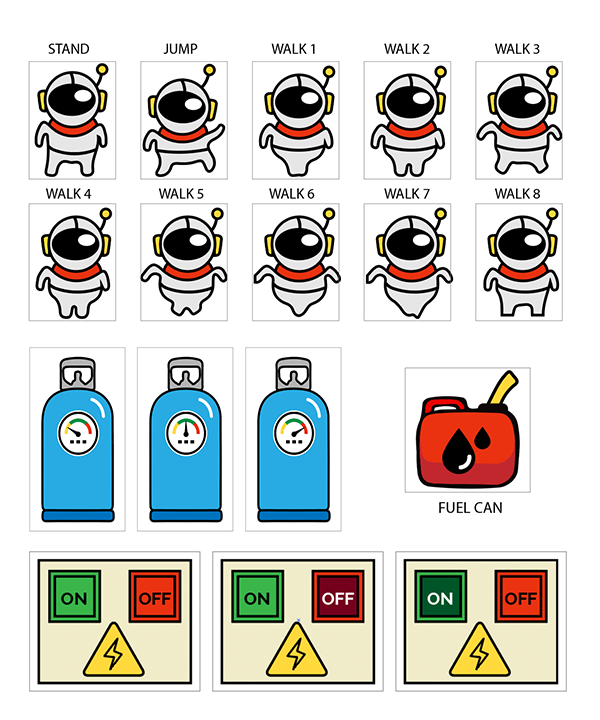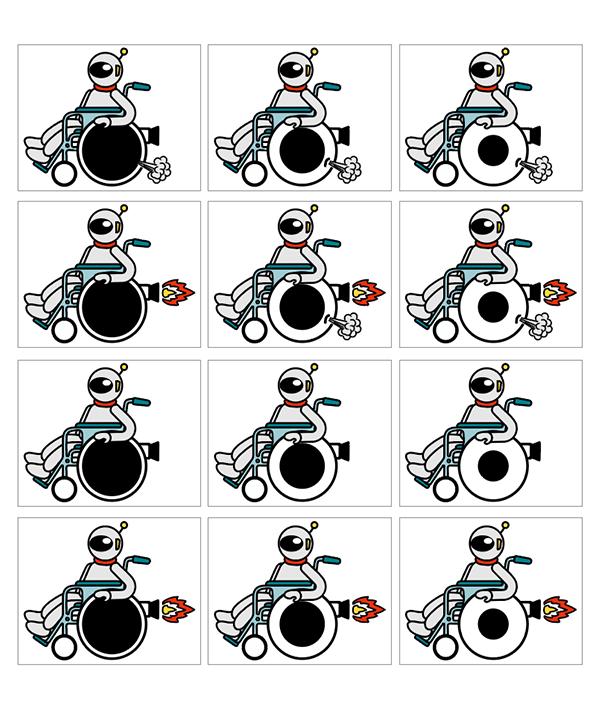Test
Gather feedback from learners, redefine and rework the problem and prototype as needed.
Allyship: Rethink Disability
Video Game Design
Goals #2 & 3: develop awareness of strengths, digital accessibility, inclusion, promote engagement and participation
Test: playcentric approach to game design, testing with real people
Watch the video game story and see a demonstration of gameplay in action:
It is the year 2121 and you play Captain Phoenix, a space pilot who crash lands onto an alien planet full of unknown dangers and challenges. In your mission to repair the ship and get back home to Earth, you learn to rethink what disability means in a new environment.
Course: ETEC 565D – Digital Games & Learning
Influential Reading: Fullerton, T. (2019)
Group Members: Aiann Oishi, Aidin Niavarani, Joe Kwan, Joyce Lo
Game Engine: G-Develop
Creative Production: Adobe Illustrator
Sample Game Assets


Reflection
Test: A Playcentric Approach to Game Design and Learning
The testing phase of design thinking provide an opportunity to get context and learn more from our users. At this stage, it’s ideal to test your prototypes with real people, which we were fortunate to do. Every member of the group had either a lived experience (as a parent, caregiver or advocate) or worked directly with the disability community.
The phrase, “all contribute to design” (Fullerton, 2019, p. 409) was a running theme for our group. It was important that suggestions be shared with an open mind, and decisions were made with everyone’s input. As Fullerton reminds us, “do it with passion and curiosity.” (p. 169). Being curious meant we didn’t shy away from asking each other difficult questions, to ensure we put the player and disability representation first.
A few examples of playcentric questions:
- Invitation to play: Are we enabling ableism, by creating a character/avatar that you “help” complete their mission? Or, is there a more inclusive way to create that “invitation to play” (p. 58) and get players interested in our game?
- Playtesting: Will we be playtesting the game with real players and members of the disability community? Think: Nothing about us without us.
- Consistency: Staying consistent with our language – if we use people-first language (i.e. people with disabilities, person using a wheelchair), we must use it consistently across our materials.
Challenges
The project was very production heavy and as the game’s sole artist, asset creation was my responsibility. As a graphic designer and web developer professionally, creating assets isn’t a challenge in itself. The challenge was the sheer volume needed with the added pressures of:
- Time: The majority of the assets had to be ready before programming could begin. Any delays in delivering the assets (to Aidin) meant potential delays in programming, and playtesting the game.
- Starting from scratch: While there are stock wheelchair illustrations and space-themed game assets, finding a ready-to-use rocket wheelchair was next to impossible.
Recommendations
We could have done a more ‘quick and dirty’ prototype, cobbling together assets from multiple sources and editing them in G-Develop’s native Piskel editor. While the end visual result wouldn’t have been as cohesive, this would allow any team member to draw and edit objects. Looking back, I would also revisit our team’s idea of completeness and balancing that with our scheduling constraints (Fullerton, 2019, p. 320-321).
Altogether, designing Allyship as a group was an incredible experience. Despite an ongoing global pandemic, different time zones and skills, we pulled together a visually appealing, kid-friendly game that I hope will spark conversations about ableism. Initial feedback from a family of kids with disabilities and staff at a disability advocacy organization has been positive. Playtesters recognized that the game was fun and easy to understand, with requests for levels of increased difficulty and secret content (i.e. themes and treasures).
Back to Stage: Empathize
Engage, observe and empathize with learners to understand behaviours and expectations.